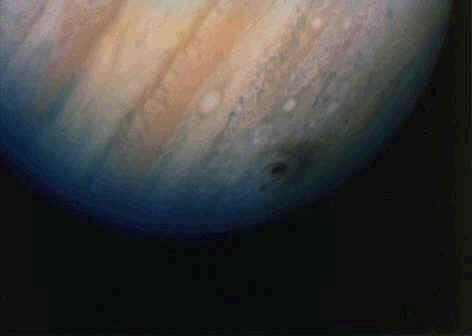|
         
> The Sun
> Mercury
> Venus
> Earth
> Mars
> Jupiter
> Saturn
> Uranus
> Neptune
> Pluto
> The 10th Planet?
> Asteroids
> Comets
> The 'Edge'
  
|
When several comets
travel in nearly the same orbit, they are said to be members of a comet
group. The most famous group includes the spectacular Sun-grazing comet,
Ikeya-Seki, of 1965, and seven others having periods of nearly a thousand
years. The astronomer Brian G. Marsden has concluded that the 1965 comet
and the even brighter comet of 1882 split from a parent comet, possibly
that of 1106. This comet and others of the group probably split away from
a truly gigantic comet thousands of years ago.
A close relationship also exists between the orbits of comets and those of
the particles (meteoroids) that produce meteor showers. The Italian
astronomer Giovanni Virginio Schiaparelli proved that the Perseid meteors,
which appear annually around August 12, are associated with Comet
Swift-Tuttle. Similarly, the Leonid meteors, which appear annually in
November, are closely associated with Comet Tempel-Tuttle. Several other
showers have been related to known cometary orbits, and are explained as
the stream of debris scattered by a comet along its orbit.
Comets were once believed to come from interstellar space. Although no
detailed theory of origin is generally accepted, many astronomers now
believe that comets originated in the outer, colder part of the solar
system from residual planetary matter in the early days of the solar
system. The Dutch astronomer Jan Hendrik Oort has proposed that a ďstorage
cloudĒ of comet material has accumulated far beyond the orbit of Pluto,
and that the gravitational effects of passing stars may send some of the
material towards the Sun, where it becomes visible as comets.
Comets have long been regarded by the superstitious as portents of
calamity or important events. The appearance of a comet has also given
rise to the fear of collision between the comet and Earth. Earth has in
fact passed through the tails of occasional comets without measurable
effect. The collision of the nucleus of a comet with Earth would probably
have catastrophic worldwide effects, but the probability of such an event
occurring is exceedingly small. Some scientists suggest, however, that
collisions have taken place in the astronomical past and may even, for
example, have had a climatic role in the extinction of the dinosaurs.
In 1992 the progenitor of Comet Shoemaker-Levy 9 produced 21 large
fragments following its exceptionally close approach to the planet
Jupiter. During a week-long bombardment in July 1994, the fragments
crashed into Jupiterís dense atmosphere at speeds of about 210,000 km/h
(130,000 mph). Upon impact, the dissipation of their tremendous kinetic
energy into heat led to massive explosions, some resulting in fireballs
larger than Earth.
 |
Shoemaker-Levy 9 Bombarding Jupiter
Fragments of Comet Shoemaker-Levy 9 collided
with Jupiter between July 16 and July 22, 1994, stirring up the
planetís atmosphere and enabling scientists on the earth to gain a
rare glimpse of the planetís interior. The comet had broken into 21
large fragments on July 8, 1992, when it ventured too close to
Jupiter. Trapped by Jupiterís strong gravitational pull, these
fragments bombarded the planet at speeds of about 210,000 km/h
(130,000 mph). This image, taken by the National Aeronautics and
Space Administrationís Hubble Space Telescope, reveals the impact
sites (dark spots near the centre of the image) created by two of
the comet fragments. |
[Back] [Top] [Next] |
